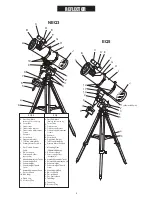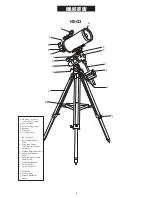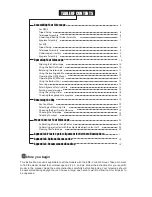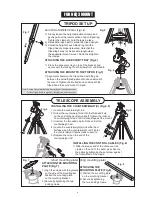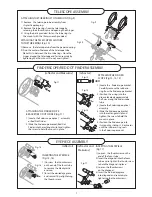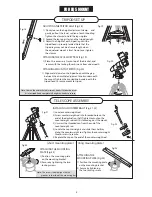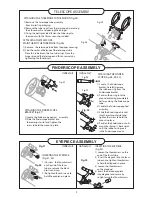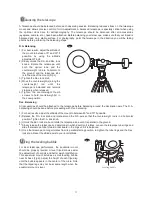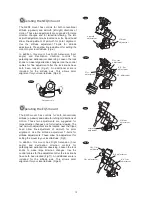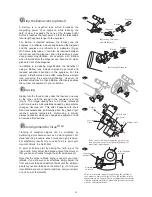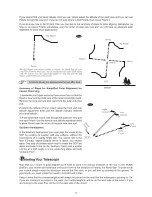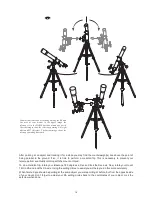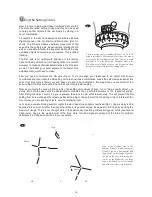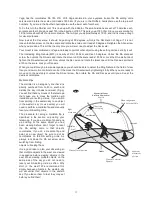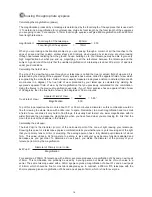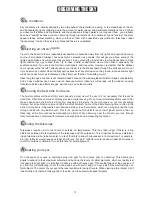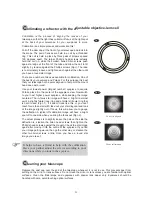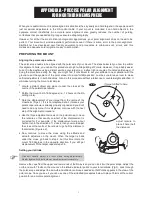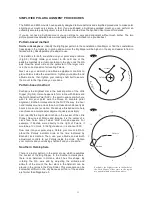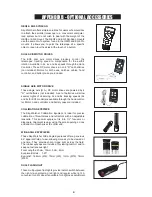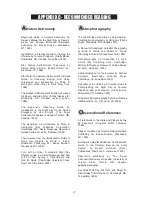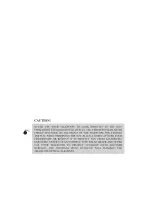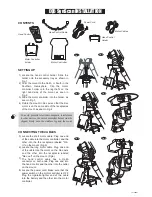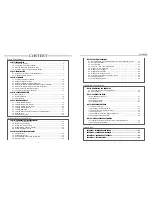
17
Vega has the coordinates RA 18h 37m. With Vega centered in your eyepiece loosen the RA setting circle
setscrew and rotate the scale until it reads 18h 36m. (If you are in the Northern hemisphere use the top row of
numbers. If you are in the Southern hemisphere use the lower set of numbers.)
To do this turn the RA dial until 18 is lined up with the indicator. The small divisions are set at 10 minutes each,
so rotate another 3 divisions past 18h in the direction of 19h. This puts you at 18h 30m. Since you are aiming for
18:36, rotate about half of one more division. That will put you approximately at 18:35, and that is close enough
for visual purposes.
Now look at the Dec scale. It should be pointing at 39 degrees, which is the Declination of Vega. If it is not,
loosen the Allen screw on the Dec scale and rotate the scale until it reads 39 degrees. Retighten the Allen screw
when you are done. This will be the only time you will ever need to adjust the Dec scale.
Your mount is now calibrated on Vega and ready to point at other objects using the setting circles. Let’s try it out.
The interesting Ring Nebula (M57) is nearby at: RA 18h 52m and Dec 33 degrees. Unlock the RA scale set
screw, then unlock the RA axis and rotate the mount until the scale reads 18h 52m. Lock the RA axis but don’t
tighten the RA setscrew just yet. Now unlock the Dec axis and rotate the telescope until the Dec axis pointer is
at 33 on the scale. Lock your Dec axis.
When you look through a low power eyepiece you should be able to detect the Ring Nebula in the field of view.
Use your slow motion controls to centre it, then lock the RA setscrew by tightening it fully. When you are ready to
move on to the next object, unlock the RA set screw, then rotate the RA and Dec axes until you arrive at the
desired coordinates.
Plane of local horizon
Nadir
Equatorial Mount
(Northern Hemisphere)
Mount aligned on
North Celestial Pole
Zenith
Right
Ascension
Apparent
movement
of stars
Plane of Celestial
Equator
Meridian
Line
Declination
Object you
are viewing
Polaris
Latitude
W
S
E
N
Meridian Flips
The meridian is an imaginary line that runs
directly overhead from north to south and
divides the sky into east and west (Fig.p).
You will find that any moves of the telescope
that cause you to cross the meridian will
invalidate your setting circles. If you switch
from pointing in the eastern sky to an object
in the western sky (or visa versa) you will
need to perform a meridian flip and manually
reset your RA setting circle.
The procedure for doing a meridian flip is
described in the section on pointing your
telescope. If you do a meridian flip and end
up pointing at the same object you had
been viewing before, don’t forget to reset
the RA setting circle to that object’s
coordinates. If you do a meridian flip and
point at a new object, be sure to put its
coordinates on the RA setting circle. As
always, lock down the RA set screw when
switching from finding
objects to tracking them.
It is a good idea to plan your observing so
that multiple objects in the west are viewed
in sequence before viewing objects in the
east. When viewing multiple objects on the
same side of the sky you do not need to
reset your RA setting circle as often. Why
start in the west? We recommend this
simply because objects in the western sky
will set earlier than objects in the eastern
sky. If you leave them to last, they may set
before you find them!
Fig.p
Содержание EQ5
Страница 1: ...INSTRUCTION MANUAL Telescopes with NEQ3 EQ5 Mount 031007V3 ...
Страница 14: ......
Страница 27: ......
Страница 29: ...INSTRUCTION MANUAL SynScan TM 140303V4 Copyright Sky Watcher ...
Страница 51: ...SynScan TM ...

